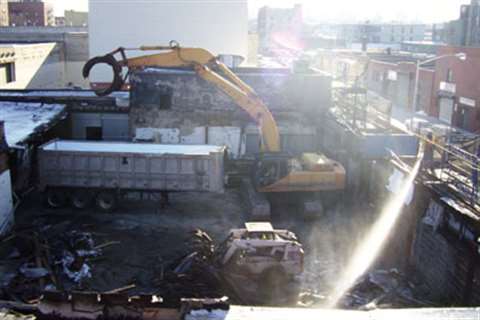Stone by stone in New York City - urban demolition challenge
20 May 2010

Working in urban areas imposes major safety challenges for demolition contractors. Damon Kozul reports on one such contract carried out in Brooklyn, New York City, New York, US.
R. Baker & Son All Industrial Services, a specialised dismantling, rigging and demolition contractor, completed a very technical selective demolition project for Con Edison in Brooklyn, New York. Con Edison purchased the property for a future substation installation and required the demolition of the buildings on the lot.
The lot consisted of several buildings on a 68.6 m by 61 m (225 ft by 200 ft) parcel in a combination residential and commercial area near downtown Brooklyn, NY.
The buildings were mostly constructed of masonry and brick walls with wooden floors and structural members. The lot was bounded on three sides by active sidewalks and a shared common wall with an occupied building on the East side.
Several of the multi-story buildings had structural problems including unsafe roofs, cracked structural beams and walls that bowed outward. In addition, a hotel bounded the southeast portion of the lot that used the alleyway for guest parking.
Numerous tasks needed to be completed to make sure the buildings were safe to demolish as well as to protect the surrounding public and active structures.
Methodologies
A detailed Health and Safety Plan, Work Plan and signed engineering drawings were developed to detail safe work practices and specific methodologies to complete the project.
A sidewalk bridge with scaffolding and netting and a wooden fence was placed around the entire lot. Several floors of the interior of the buildings needed to be shored to prevent uncontrolled collapse.
Utility disconnects and isolations were coordinated and verified. Several fuel storage tanks and associated piping were pumped and cleaned of product, which was sent offsite for recycling.
All necessary permits were obtained including hot work, demolition, asbestos removal, sidewalk closing and crossing. As an additional safety measure and to ensure public safety, security was maintained 24hrs a day.
Before demolition activities could be conducted, the structures needed to be abated of asbestos containing materials (ACM). This consisted of roofing materials, piping insulation, boiler insulation and gaskets.
The insulation and gasket materials were abated using standard asbestos removal procedures. Due to the structural instability of the roofs, a variance was obtained to abate the ACM roofs using mechanical means and wet methodology.
An asbestos trained operator in a Case 9060B excavator with grapple carefully removed the roofs, while trained laborers performed dust suppression, and placed the ACM directly into lined rolloffs.
Safe demolition
In order for the buildings to be safely demolished, several wall bracing systems needed to be installed. The wall bracing and shoring design was performed by a licensed professional engineer, which was submitted for NYC Building Department approvals.
Upon approval, steel bracing was installed along the shared common wall, which needed to remain in an undamaged condition, as well as along the northern basement wall.
Safety for workers and the surrounding public was first and foremost throughout the entire project. The dedicated Site Safety Officer, Henry Walburger, conducted daily safety meetings and made sure that proper safety procedures were always followed.
Workers not only wore standard Level D PPE but also put on high visibility safety vests. Henry also made sure that dust suppression was maintained and that spotters were used along the perimeter to ensure public safety.
A significant amount of manual demolition needed to be conducted prior to any mechanical demolition. As part of the demolition permit, structures needed to be manually brought down to fewer than 2 stories in height.
In addition, careful surgical demolition needed to be conducted to separate the structural members along the shared common wall which needed to remain. Workers with saw-salls and chipping guns working from aerial work platforms and scaffolding carefully made the necessary separations and gaps.
Once the buildings were hand demolished to a safe height and the necessary separations had taken place, mechanical demolition commenced.
Top slab
Two Case 9060B excavators with grapples were used to perform the demolition of the buildings to top of slab. These excavators, along with a Doosan DX300-LC with a 5,000lb hammer attachment, were used to demolish the concrete slabs.
To ensure the buildings were safely demolished, R. Baker & Son assigned two of their key operators/managers to the project.
Mark Baker and Mike Masucci, both with 20+ years of experience, worked in tandem to carefully dismantle the structures.
R. Baker & Son's commitment to recycling and philosophy of being "green" was implemented throughout the demolition operations.
Metals, concrete and brick were sent offsite for recycling.Wood timbers, consisting of yellow pine and Douglass fir, were salvaged and sent to a mill for reuse as architectural wooden beams and hardwood flooring.
Once demolition was completed, restoration activities were then implemented. The site was backfilled with clean fill and then topped off with several inches of clean stone.
A perimeter chain link fence and access gates were installed. The sidewalks were repaired and restored.
Due to the team of Con Edison and R. Baker & Son's attention to pre-planning, safety implementation and work execution, the project was successfully completed without any incidents or accidents.




